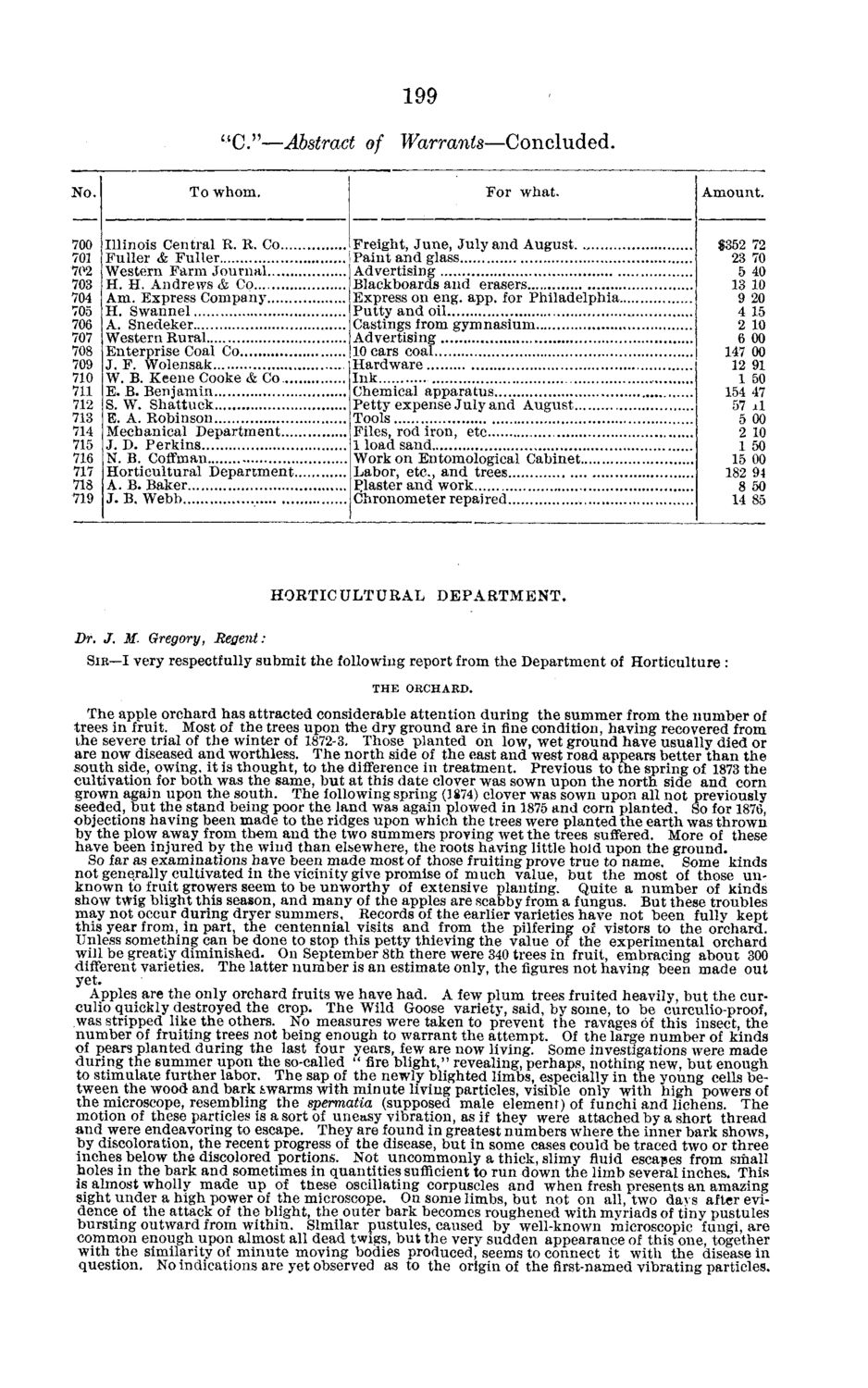| |
| |
Caption: Board of Trustees Minutes - 1876
This is a reduced-resolution page image for fast online browsing.

EXTRACTED TEXT FROM PAGE:
199 "C."—Abstract of No. 700 701 7Pfl 708 704 705 700 707 708 709 710 711 71? 713 714 715 710 717 718 719 To whom. Illinois Central R. R. Co Fuller & Fuller Western Farm Journal H. H. Andrews & Co Am. Express Company H. Swannel A. Snecleker Western Rural Enterprise Coal Co J. F. Wolensak W. B. Keene Cooke & Co. E. B. Benjamin S. W. Shattuek E. A. Robinson Mechanical Department J. D. Perkins N. B. Coffman Horticultural Department A. B. Baker J. B. Webb Warrants—Concluded. For what. Amount. 8352 72 23 70 5 40 13 10 9 20 4 15 2 10 6 00 147 00 12 91 1 50 154 47 57 xl 5 00 2 10 1 50 15 00 182 94 8 50 14 85 Freight, June, July and August Paint and glass Advertising Blackboards and erasers Express on eng. app. for Philadelphia Putty and oil Castings from gvmnasium Advertising 10 cars coal Hardware Ink Chemical apparatus Petty expense July and August Tools Files, rod iron, etc 1 load sand Work on Entomological Cabinet Plaster and work Chronometer repaired HORTICULTURAL DEPARTMENT. Dr. J. M. Gregory, Regent: SIR—I very respectfully submit the following report from the Department of Horticulture : THE ORCHARD. The apple orchard has attracted considerable attention during the summer from the number of trees in fruit. Most of the trees upon the dry ground are in fine condition, having recovered from the severe trial of the winter of 1872-3. Those planted on low, wet ground have usually died or are now diseased and worthless. The north side of the east and west road appears better than the south side, owing, it is thought, to the difference in treatment. Previous to the spring of 1873 the cultivation for both was the same, but at this date clover was sown upon the north side and corn grown again upon the south. The following spring (1874) clover was sown upon all not previously seeded, but the stand being poor the land was again plowed in 1875 and corn planted. So for 1876, objections having been made to the ridges upon which the trees were planted the earth was thrown by the plow away from them and the two summers proving wet the trees suffered. More of these have been injured by the wind than elsewhere, the roots having little hoid upon the ground. So far as examinations have been made most of those fruiting prove true to name. Some kinds not generally cultivated in the vicinity give promise of much value, but the most of those unknown to fruit growers seem to be unworthy of extensive planting. Quite a number of kinds show twig blight this season, and many of the apples are scabby from a fungus. But these troubles may not occur during dryer summers. Records of the earlier varieties have not been fully kept this year from, in part, the centennial visits and from the pilfering of vistors to the orchard. Unless something can be done to stop this petty thieving the value of the experimental orchard will be greatly diminished. On September 8th there were 340 trees in fruit, embracing about 300 different varieties. The latter number is an estimate only, the figures not having been made out yet. Apples are the only orchard fruits we have had. A few plum trees fruited heavily, but the curculio quickly destroyed the crop. The Wild Goose variety, said, by some, to be curculio-proof, was stripped like the others. No measures were taken to prevent the ravages of this insect, the number of fruiting trees not being enough to warrant the attempt. Of the large number of kinds of pears planted during the last four years, few are now living. Some investigations were made during the summer upon the so-called " fire blight," revealing, perhaps, nothing new, but enough to stimulate further labor. The sap of the newly blighted limbs, especially in the young cells between the wood and bark swarms with minute living particles, visible only with high powers of the microscope, resembling the spermatid (supposed male element) of funchi and lichens. The motion of these particles is a sort of uneasy vibration, as if thev were attached by a short thread and were endeavoring to escape. They are found in greatest numbers where the inner bark shows, by discoloration, the recent progress of the disease, but in some cases could be traced two or three inches below the discolored portions. Not uncommonly a thick, slimy fluid escapes from small holes in the bark and sometimes in quantities sufficient to run down the limb several inches. This is almost wholly made up of these oscillating corpuscles and when fresh presents an amazing sight under a high power of the microscope. On some limbs, but not on all, two days after evidence of the attack of the blight, the outer bark becomes roughened with mvriads of tiny pustules bursting outward from within. Similar pustules, caused by well-known microscopic fungi, are common enough upon almost all dead twigs, but the very sudden appearance of this one, together with the similarity of minute moving bodies produced, seems to connect it with the disease in question. No indications are yet observed as to the origin of the first-named vibrating particles.
| |